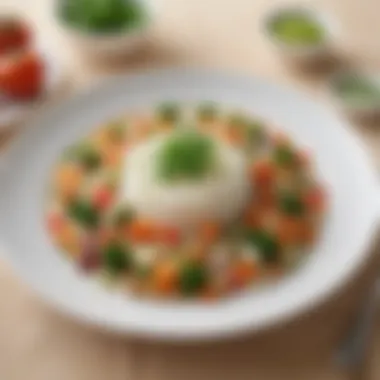Exploring No Calorie Rice: Culinary Efficiency Unveiled


Intro
The concept of no calorie rice has garnered increasing attention. Given the challenges of dietary management and the societal inclination toward healthy eating, alternatives like no calorie rice present intriguing solutions. This guide seeks to explore various aspects of no calorie rice, offering insights for culinary enthusiasts.
By evaluating origins, nutritional highlights, and cooking applications, one will understand its unusual appeal. Furthermore, practical recipes and cooking tips will support readers looking to efficiently integrate no calorie rice into their culinary repertoires. This discussion is not merely about substituting traditional rice. It implies a broader inquiry into contemporary cooking, nutrition, and lifestyle choices.
Recipe Overview
Cooking with no calorie rice isn’t limited to boring dishes. Here’s a transformational recipe to kickstart your culinary journey:
Zesty No Calorie Rice Stir-Fry
- Portions: 4
- Prep and Cook Time: 20 minutes
- Difficulty: Easy
- Main Ingredients:
- No calorie rice (such as konjac rice)
- Mixed vegetables (like bell peppers, broccoli, and carrots)
- Soy sauce
- Garlic and ginger
- Olive oil
Step-by-Step Instructions
- Prepare Ingredients:
- Cooking Process:
- Rinse no calorie rice in cold water per package instructions. This ensures it's ready for cooking.
- Chop mixed vegetables into bite-sized pieces. Mince garlic and ginger for extra flavor.
- Heat olive oil in a non-stick pan over medium heat.
- Add garlic and ginger, stirring until fragrant, around 1-2 minutes. Be careful not to burn.
- Incorporate mixed vegetables and stir-fry for 5-7 minutes until they're vibrant and slightly tender.
- Lastly, mix in rinsed no calorie rice and soy sauce. Stir everything together for another 3-4 minutes, ensuring even distribution of flavors.
Time-Saving Strategies:
- Chop veggies ahead of time and store them in the fridge.
- Substitute fresh garlic and ginger with pre-minced varieties.
Nutritional Information
- Calorie Count per Portion: 100 calories (approximately)
- Nutritional Breakdown:
- Beneficial Nutrients: This dish is an excellent source of vitamins from the mixed vegetables, fiber due to no calorie rice, and it aids in hydration.
- Proteins: 3g
- Fats: 4g
- Carbohydrates: 12g
Quick Cooking Tips
- Try using an air fryer to add a different texture: Cook the mixed vegetables in the air fryer for 10 minutes before adding them to the pan.
- Multitask by preparing the no calorie rice while you stir-fry the vegetables; this can shave vital time off meal prep.
- Incorporate different proteins like tofu or shrimp to suit dietary preferences.
Related Recipes & Variations
- Consider trying a spicy no calorie rice salad for lunch or dinner, which pairs perfectly with the stir-fry.
- Adaptations for vegan dietary needs could include replacing soy sauce with a gluten-free version or using vegetable broth instead of oil for cooking.
Intro to No Calorie Rice
The exploration of no calorie rice is essential in the realm of modern culinary practices. As society increasingly shifts towards health-conscious choices, the quest for lower-calorie alternatives becomes more pivotal. No calorie rice directly responds to growing preferences for food that assist in maintaining weight while maximizing meal volume. Understanding this concept allows culinary enthusiasts to expand their cooking toolkit with creative substitutes that add texture and substance without hindering dietary goals.
Defining No Calorie Rice
No calorie rice primarily refers to ingredients designed to replicate traditional rice's texture and aesthetic, without contributing significant calories to meals. This often most prominently includes shirataki rice, made from the konjac yam. Unlike standard rice varieties, which offer around 200 calories per cup, no calorie rice alternatives serve as a substitute and can enhance a meal's visual bulk, often containing negligible calories.
The importance of delineation here is paramount, not just for conscious chefs but also for consumers eager to substitute higher-calorie foods. This distinction permits the formation of dishes that remain flavorful yet guilt-free, appealing especially to those undertaking changes in diet.
Historical Context and Development
The origin of no calorie rice can be traced back to Asian culinary traditions, where the konjac yam has been utilized for centuries. Shirataki noodles emerged from this plant, traditionally used in Japanese cuisine, and gained popularity in Western countries synthological advancements made its powder accessible for a mirroring rice alternative.
Initially embraced by health advocates seeking reduced carbohydrate options in dishes, no calorie rice has carved a supace within larger diet trends.


In the last few decades, innovations in food technology has contributed to the rise and better flavor/deceptor qualities of these products. Modern manufacturing processes have advanced taste and texture, prompting broader acceptance into mainstream diets. No calorie rice serves not only as culinary efficiency but also distinctly reflects the growing desires for nutritious alternatives.
Nutritional Profile of No Calorie Rice
Understanding the nutritional profile of no calorie rice is essential for anyone looking to incorporate it into a healthy diet. This section discusses immediate advantages, offers insights on benefitting from these alternatives, and highlights key nutrients found in various no calorie rice forms. Exploring these details can equip culinary enthusiasts with a more comprehensive understanding of how to use no calorie rice effectively.
Understanding Caloric Density
Caloric density plays a crucial role when discussing no calorie rice. This concept refers to the number of calories in a given volume of food. Traditional rice has a high caloric density, but no calorie rice disguises this fact by offering minimal to no calories. When you swap out high-calorie grains with no calorie rice options, you effectively consume larger portions without increasing caloric intake. This supports weight management since consuming lower calorie meals can help control hunger and reduce overall daily calorie consumption.
No calorie rice achieves such low density primarily due to its high water content. Most varieties, particularly Shirataki, are composed of around 95% water. This results in varied meal volumes despite, the low caloric value of just a few calories per serving. For those monitoring their calorie intake, substituting traditional rice for no calorie rice becomes a strategic move to enjoying hearty meals without burdening caloric budgets too much.
Vitamins and Minerals Content
Even though no calorie rice is low in calories, it does possess a range of vitamins and minerals, providing intrinsic culinary value. The most prominent example is Shirataki rice, derived from the konjac yam. Notably, it is rich in glucomannan—a soluble fiber recognized for its various health benefits.
Regarding micronutrients, many no calorie rice alternatives do not offer substantial amounts. It's vital to consume these rice options alongside nutrient-rich foods to ensure dietary balance. Combining no calorie rice with vegetables, proteins, and healthy fats augments the overall nutrient intake of a meal. As such, one should aim for a varied diet that includes the essential vitamins and minerals otherwise lacking when consuming solely no calorie rice.
Integrating no calorie rice in meals can complement nutrient-rich ingredients that improve overall dietary satisfaction while restricting calories.
Fiber and Digestive Health
Another significant facet of no calorie rice is its fiber content, primarily contributed by glucomannan found in konjac. Fiber delivers numerous health benefits, especially concerning digestive health. It assists in regulating bowel movements and contributing to a well-functioning gut. Including foods high in soluble fiber can also aid in stabilizing blood sugar levels, as fiber slows the absorption of sugar in the blood and aids digestive processes.
Ultimately, increasing fiber intake can have compounding effects on overall health. Incorporating no calorie rice in a balanced diet can facilitate enjoyable meals while fostering digestive wellness. For someone aiming for better digestive health, combined with daily hydration, no calorie rice options present the opportunity for satisfying solution
Popular Types of No Calorie Rice
The availability of various types of no calorie rice enhances the options for culinary enthusiasts. It is essential to explore these different varieties, as they each present unique benefits, nutritional profiles, and utilizations in the kitchen. This section covers three of the most prominent types of no calorie rice, each suitable for specific dietary objectives and culinary techniques.
Shirataki Rice
Shirataki rice is made from the konjac plant, mainly grown in Asia. It contains a substance called glucomannan, a soluble fiber that is the key element to its no-calorie nature. This rice alternative is popular among those on low-carb or ketogenic diets. The texture of Shirataki rice is somewhat chewy and can absorb flavors well, making it versatile for stir-fries and rice-based dishes.
Benefits of Shirataki Rice:
- Low in Calories: The primary draw is its calorie content, or lack thereof. Each serving typically carries a mere few calories, depending on rinsing and prep factors.
- Fiber-Rich: The glucomannan may contribute to a feeling of fullness, supporting those looking to manage weight.
- Easy Preparation: Shirataki rice comes ready to use, requiring only washing and heating before it can be integrated into meals.
While it presents significant benefits, an acquired taste and texture might deter some. However, with proper seasoning and integration into flavorful dishes, it can stand out in culinary creations.
Vegetable-Based Alternatives
Vegetable-based rice alternatives include cauliflower rice and zucchini rice. These choices cater to those aiming for more nourishing and wholesome meals while keeping their calorie intake low. Grated or finely processed, these vegetables can emulate the texture of traditional rice.
Advantages include:
- Rich in Nutrients: Unlike traditional rice, vegetable-based options often provide additional vitamins and minerals, including antioxidants that promote health benefits.
- Customizable Flavor Profiles: Creating variations with vegetables allows for easy incorporation of spices and herbs to match personal tastes preference.
- Increased Color and Presentation: Using different colored veggies not only adds interest but also enhances the visual appeal of a dish.
However, using vegetable alternatives may require slight adjustments during cooking, as they have their own water content and may alter the expected dish's structure.
High-Fiber Grain Substitutes
While traditionally rice is a grain, high-fiber substitutes, like quinoa and farro, often appear in the context of a low-calorie lifestyle. These grains contain moderate calories but pack substantial nutritional value. Quinoa, for instance, has a high protein content and contains all the essential amino acids, framing it as a wholesome choice for various dietary preferences.
Key Points to Consider:
- Nutritious Grains: They may be higher in calories compared to rice alternatives, yet they provide better fiber profiles, encouraging digestive health and prolonged satiety.
- Versatile in Cooking: Much like regular rice, they can be incorporated into a range of dishes from salads to casseroles, serving as robust bases.
- **Ease in Preparation:**Usually requires simmering until tender, many people find these grains straightforward and fulfilling when prepared correctly.
The challenge lies in balancing these choices within one’s dietary goals while getting creative in the kitchen.


The integration of no calorie rice alternatives not only presents myriad flavors and textures but allow those looking for dietary change to explore new culinary territories.
Culinary Applications of No Calorie Rice
Culinary applications of no calorie rice are critical in illustrating how these products can fit effortlessly into modern diets. With the rising interest in health and wellness, the ability to make meals more substantial without adding calories responds to a clear demand in culinary practices. The importance of no calorie rice lies in its versatility and its ease of incorporation into various dishes. This section will review how these alternatives can be utilized in meals, benefiting those who aim for healthier eating habits.
Incorporating No Calorie Rice into Everyday Meals
Incorporating no calorie rice into daily meals can be simple. High-diet individuals can benefit greatly. Options, such as Shirataki rice, are quick solutions that replace traditional rice without affecting nutrient distribution negatively. Pairing these options in everyday cooking can result in very filling meals while reducing overall caloric intake. This can prove significant during the hustle of daily life when time and health are both top considerations.
Easy Recipes Featuring No Calorie Rice
Stir-Fry Variations
Stir-fry variations using no calorie rice are popular due to their quick preparation and ease. They offer adaptability for various ingredients, from proteins to vegetables. One notable aspect is the blend of flavors that enhances the meal without additional carbs. Stir-fried dishes featuring Shirataki rice hold outstanding potential, with only a fraction of the calorie load. A benefit is the dietary requirement they meet, from vegan to low-carb diets, appealing to a wide audience.
Salad Integrations
Integrating no calorie rice into salads offers unique textures and bulk, changing the way salads are approached. Guests might find them satisfying when combined with fresh greens, nuts, and proteins. The light nature of Shirataki rice complements dressings well, maintaining flavor effectiveness. The rare drawback could be their adherence to the other ingredients if not mixed evenly, which might deter some precision eaters.
Soup and Stew Enhancements
Adding no calorie rice to soups and stews adds volume without the burden of calories. This improves the body of a dish while reducing fat content — making food feel richer. Shirataki rice aids in achieving thicker consistent results. However, using too much may take away from primary flavors. It's vital to help maintain a balance between the core elements and the enhancements for optimal results.
The proper incorporation of no calorie rice can yield substantial benefits, transforming your cooking without limitation of taste or satisfaction.
Benefits of Using No Calorie Rice
The use of no calorie rice alternatives is significant for many reasons. Key benefits extend beyond just the number of calories. For individuals focused on health and well-being, understanding these benefits includes considerations of weight management, blood sugar regulation, and meal volume. Adopting no calorie rice can play a role in achieving these health goals.
Weight Management
One primary advantage of no calorie rice is weight management. Traditional diets often struggle under the burden of calories. There is a clear linkage here: by replacing higher-calorie food with no calorie alternatives, individuals can create lower-calorie meals without the feeling of restriction. This approach promotes satiety while helping to control overall caloric intake.
By integrating no calorie rice, dieters may enjoy larger portions and feel psychologically more satisfied, leading to sustainable eating habits.
Including these rice alternatives allows for more substantial meals without sabotaging dietary goals. The feeling of fullness can aid the struggle against cravings, as eating substantial volume may improve overall satisfaction with meals, leading to more enforceable lifestyle changes.
Blood Sugar Regulation
Another important benefit of no calorie rice involves its impact on blood sugar regulation. Foods that have low caloric value typically provide fewer carbohydrates. This attribute can help individuals managing conditions such as diabetes maintain stable blood sugar levels. When traditional rice is substituted, there may be less fluctuation in blood glucose.
Vegetable-based no calorie rice options, in particular, are designed to be nutrient-rich while leading to optimal physical response in terms of glucose management. Thus, there could be enhanced well-being overall. It's worth noting that incorporating these alternatives should be done within the context of a balanced diet.
Increased Meal Volume Without Extra Calories
Lastly, one more compelling characteristic of no calorie rice is the ability to achieve increased meal volume without extra calories. This is crucial for those who need satisfying portion sizes but wish not to exceed recommended caloric limits. By filling plates with no calorie rice, eaters can enjoy balanced meals that appear dense and substantial but remain low-calorie.
For busy lifestyles, this means meals can be constructed rapidly while avoiding the maintenance of cumbersome calorie counts. Following a busy day, when convenience is essential, no calorie rice becomes an invaluable tool for success in the kitchen.
In summary, the benefits of using no calorie rice alternatives extend through various aspects of healthy living—from weight management to comprehensive dietary control. Adding these rice-like elements breaks new ground not only in meal planning but also in everyday eating
Potential Drawbacks of No Calorie Rice
Considering no calorie rice alternatives, it is crucial to understand their drawbacks. Even with their appeal, these products may present certain issues for various consumers. Assessing these drawbacks provides a balanced view of no calorie rice and informs better culinary decisions.
Taste and Texture Considerations


While no calorie rice can offer substantial benefits regarding calorie reduction, its taste and texture are important elements to evaluate. Many users report that no calorie rice can have a distinct or even artificial flavor. This comes from a lower starch content compared to regular rice. The texture varies between brands, with some being overly chewy or gelatinous, which may not be appealing for all. Adjusting seasonings and cook methods can help, but
- Palate and Preferences: The taste can be a dealbreaker for purists or those who find comfort in traditional flavors.
- Possible Modifications: Simple enhancements can improve enjoyment, which can require additional effort in preparation.
Cost Comparisons
Despite no calorie rice being marketed as a healthy alternative, their pricing is often higher than traditional options.
- Factors Influencing Price: No calorie rice, such as Shirataki products, can be quite costly due to production and shipping processes. Research from various sources shows that significant price variation exists among brands.
- Cost vs. Caloric Benefit: It's vital to weigh if the price difference justifies the health benefits, particularly for regular consumption. Overall, evaluating whether the expense fits within a personal budget deserves consideration.
Digestive Issues for Some Consumers
Some individuals experience digestive discomfort when consuming no calorie rice. This concern often relates to the glucomannan fiber in Shirataki rice and other similar products.
- Potential Symptoms: Users might face bloating and abdominal discomfort. Moderate consumption is often advised. Monitoring individual reactions is prudent, especially when factors vary per person.
- Consultation with Healthcare Providers: Not all consumers might face digestive complications, but those that do should consider discussing it with a registered dietician or a medical professional.
Consumer Insights and Trends
The section draws attention to discerning how no calorie rice fits into contemporary consumer behaviors, preferences, and market movements. Understanding these insights is essential for any culinary enthusiast, as it informs which products genuinely meet modern dietary regulations while aligning with health trends. Such insight offers added dimensions to how no calorie rice is integrated into daily cooking, making it paramount in today's fast-paced lifestyle.
Market Demand for Low-Calorie Alternatives
The market is increasingly leaning towards low-calorie alternatives due to rising health awareness. People prioritize not only weight management but also overall well-being. This push leads to growth in demand for no calorie rice and other substitutes that do not compromise dietary satisfaction. Retailers have noted that brands producing these alternatives are witnessing robust consumer interest, especially among groups seeking high-fiber and low-carb options.
Surveys indicate more customers actively consider calories when selecting food products.
- Health Conscious Consumers: Many individuals are making a significant effort to reduce their caloric intake. This trend influences shopping behaviors, compelling brands to develop no calorie rice varieties like Miracle Rice or dynamic vegetable blends.
- Dietitian Recommendations: Nutritionists often suggest these products, enhancing market confidence and desirability. Reputable endorsements increase the likelihood of adoption among potential users.
“As consumers evolve, the move towards low-calorie meal options simultaneously supports healthier choices and personal culinary creativity.”
Such transformations raise not only demand but also expectations around taste, texture, and authenticity of flavors.
Culinary Preferences and Adaptation
Culinary preferences concerning no calorie rice continue to evolve, paralleling the holistic approach towards dieting and meal preparation. Chefs and home cooks adjust numerous aspects of their cooking to account for textures and flavors associated with such products.
This adaptation isn't just a trend. It speaks volumes about how preferences shift in response to practical cooking habits and dining experiences.
- Innovative Integrations: Creative usage of no calorie rice fosters the need for recipes to incorporate flavors effectively. Traditional dishes are often reimagined to feature this ingredient.
- Social Media Influence: Platforms motivate followers to explore culinary experimentation and provide ideas for cookery. As influencers demonstrate versatility, others are encouraged to embrace these changes in cooking.
Embracing innovation allows no calorie rice to thrive in multi-cultural cuisines while personal tastes adjust dynamically, forming engagement appealing across new and seasoned cooks alike.
The current fondness for health-centered alternatives remains crucial in bridging traditional cooking with modern nutrition applications.
Incorporating No Calorie Rice into a Busy Lifestyle
In today’s fast-paced world, finding ways to eat healthily while managing a busy schedule is a common challenge. Incorporating no calorie rice presents an efficient solution. These alternatives not only serve as substitutes for traditional grains but can also help enhance meal volume without adding significant calories. With clever meal prep strategies and quick cooking techniques, consumers can enjoy nutritious dishes with minimal effort.
Meal Prepping Strategies with No Calorie Rice
Meal prepping is essential for busy individuals looking to maintain proper nutrition. One effective strategy is batch cooking various meals using no calorie rice. When preparing dishes like stir-fries or salads, one can use products such as Shirataki rice or other no calorie alternatives.
To simplify the process, try the following steps:
- Plan Ahead: Select a few recipes that include no calorie rice. Make a shopping list to ensure you have all ingredients ready.
- Batch Cooking: Prepare a large quantity of no calorie rice at once. You can store it in the refrigerator or freeze it for later use. Just ensure it is in an airtight container.
- Versatile Combinations: Combine no calorie rice with proteins, vegetables, and sauces to create a variety of meals.
- Divide into Portions: Pre-portion your meals in individual containers. This makes it easy to grab and go, eliminating the need for cooking during busy days.
Meal prepping not only saves time but also allows for better portion control. Leveraging these strategies can significantly improve the efficiency of incorporating no calorie rice into a busy lifestyle.
Quick Cooking Tips and Techniques
Efficiency in the kitchen is vital for those who want to incorporate no calorie rice without spending hours cooking. Here, quick cooking tips can be the game changer that allows for rapid meal creation without sacrificing quality.
- Utilize the Right Tools: A rice cooker or microwave can speed up cooking time. Shirataki rice, for example, typically requires just a few minutes to heat,
- Skip Complex Preparations: Use ready-made sauces or pre-chopped vegetables to save time. This creates quick, flavorful dishes in little time.
- Smart Use of Leftovers: For an easy meal, save leftovers and combine them with reheated no calorie rice. This practice can turn simple leftovers into a delicious meal.
- Keep Cooking Simple: Stick to straightforward recipes that require fewer dishes. This minimizes cleanup and maximizes speed.
Busy lifestyles demand considered approaches to nutrition. Integrating no calorie rice opens new avenues to healthful and quick meal creation. Utilizing meal prepping strategies and smart cooking techniques ensures continued access to satisfying, nutritious meals regardless of your schedule.







